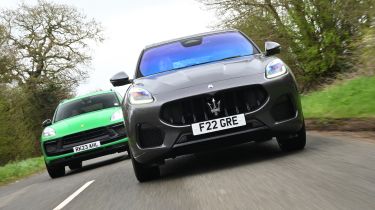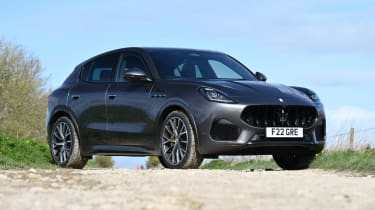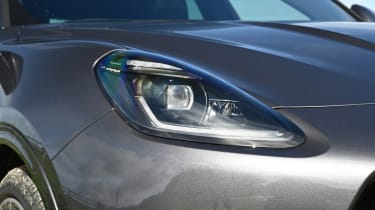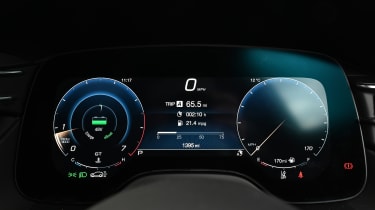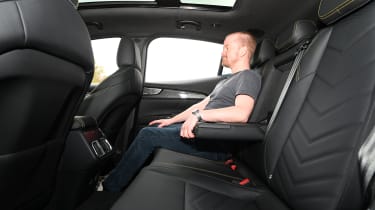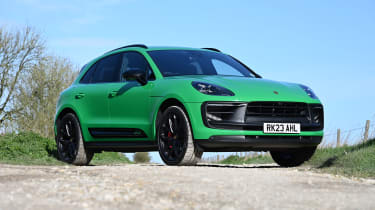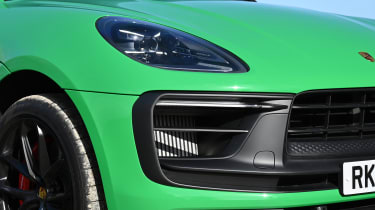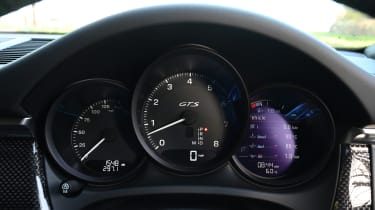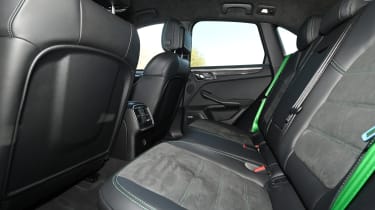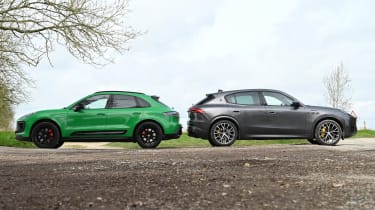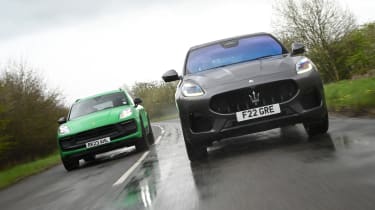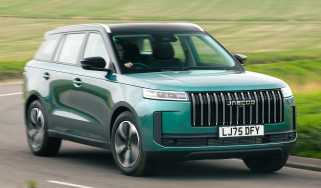Maserati Grecale vs Porsche Macan: 2023 twin test review
Can the Maserati Grecale beat the Porsche Macan for hot-SUV honours?
It doesn’t matter whether a car maker specialises in luxury vehicles or mass-market machines – pretty much all of them offer an SUV.
Porsche was one of the first performance marques to expand its portfolio with an SUV, and the Cayenne is credited with turning the company’s fortunes around.
Maserati’s first SUV was the Levante, but it has now introduced the slightly smaller Grecale, a car that goes head to head with Porsche’s smallest SUV, the Macan. With the latter due to be replaced soon, can the newcomer usurp the master of the hot SUVs?
| Maserati Grecale Modena | Porsche Macan GTS | |
| Price: | £67,810 | £71,700 |
| Powertrain: | 2.0-litre 4cyl turbo MHEV, 325bhp, eight-speed auto | 2.9-litre V6 turbo, 434bhp, seven-speed auto |
| 0-62mph: | 5.3 seconds | 4.3 seconds |
| Test efficiency: | 24.2mpg/5.3mpl | 23.9mpg/5.3mpl |
| CO2: | 210g/km | 265g/km |
| Annual VED: | £560 | £570 |
Maserati Grecale
A price of £67,810 sees the Grecale Modena undercut the Macan GTS by around £4,000. However, it only has a four-cylinder engine, while adding options brings price parity with the Porsche.
Tech highlights
This medium-sized SUV is an all-new Maserati, but under the skin it makes use of some familiar technology. It’s based a variation of the Giorgio platform that underpins the Alfa Romeo Giulia and Stelvio, and given that these two sit near the top of their respective classes when it comes to ride and handling – especially in hot Quadrifoglio form – that seems like a very solid place to start.
Used - available now

2024 Volkswagen
Golf GTE
14,668 milesAutomaticPetrol1.4L
Cash £21,976
2020 Volkswagen
Tiguan
39,131 milesAutomaticDiesel2.0L
Cash £21,697
2022 BMW
3 Series
30,514 milesAutomaticPetrol2.0L
Cash £21,397
2026 Audi
A1 Sportback
6,600 milesAutomaticPetrol1.5L
Cash £21,176While an all-electric Folgore model will join the range soon, for now Grecale buyers have a choice of three powertrains. There are two four-cylinder turbocharged models, producing 296bhp in the GT and 325bhp in the Modena tested here. Each gets a 48-volt mild-hybrid system that recovers energy under deceleration to charge a small battery, which in turn powers a small electric motor to add a modest boost in performance and throttle response.
Maserati has placed the DC converter and the 48V battery close to the rear axle to improve weight distribution, while the car’s official kerbweight is rated at 1,895kg, which is lighter than the V6-powered Macan. The range- topping Trofeo features a 3.0-litre V6 and jumps up both in power (523bhp) and price (£99,700).
Our Modena test car was fitted with optional air suspension. Called ‘Skyhook’ in the Maserati options list, it’s a £1,400 extra.
Safety: The Grecale hasn’t been tested by Euro NCAP yet, but all models get six airbags and lane- keep assist. All-round parking sensors should help drivers avoid low-speed bumps.
On the road
The Grecale manages to deliver some impressive driving dynamics in some areas, but it doesn’t quite gel together as one cohesive package.
Around town: Even though people expect a degree of control and responsiveness from any performance car – even a fast SUV – the Grecale’s ride often feels just a little too firm. This can lead to a jiggling sensation at low speeds. However, the quality of the damping is clearly high, so it rarely feels harsh or crashy.
A & B-roads: Maserati allows the driver to control the dampers independently of the five drive modes (Offroad, Comfort, GT, Sport and Corsa). In other words, it’s possible to opt for the livelier powertrain modes with the softer of two suspension settings – the one that’s best suited to the general state of UK roads.
While body control is impressive for such a large car, the Grecale exhibits a slightly nose-heavy attitude. This is partly masked by a fast steering set-up, which gives a very quick initial turn in but then a lot of resistance once the chassis catches up.
It’s a similar story for the powertrain. The 2.0-litre turbo produces strong low-down torque, which gives strong initial acceleration when combined with the mild-hybrid assistance.
However, it quickly tails off, leaving little incentive to rev it towards the red line. The Grecale doesn’t feel as quick as its 5.3-second 0-62mph time suggests.
Motorway: Hyperactive steering gives an impression of agility at lower speeds, but it also means the Grecale feels busy on the motorway, with regular corrections needed. The fidgety sensation from the suspension tends to linger at higher speeds, too.
Ownership
While the Grecale’s driving experience doesn’t quite blow us away, the way it feels inside is a much greater success. The cabin manages to keep many of the details that have made previous Maserati interiors feel special, while simultaneously moving things on into the current decade.
The dash-mounted clock is a prime example. It sits in its typical top-centre spot on the fascia, but is now a small digital screen, which can display a chronometer, compass, G-meter and even the voice control for the voice-activated on-board assistant. Beyond all of that, it can still tell the time in either analogue or digital form.
It’s one of four separate screens inside – five if you count the head-up display. There are a pair of 12.3-inch screens – one for the instrument panel, another for the main infotainment system – and a further touchscreen display just below. This 8.8-inch screen is for the climate controls, driving modes and, less successfully, the lights.
That slight ergonomic flaw aside, the Grecale is impressive. The feel of the steering wheel, the gearshift paddles and the soft leather on the seats all give a fantastic feeling of expense, and the general build quality is very close to the Porsche’s standard. The driving position has plenty of adjustment, too.
Despite the mild-hybrid tech, we found the Grecale to be fairly thirsty during our time with it, averaging a fairly underwhelming 24.2mpg. All Grecales come with a three-year, unlimited- mileage warranty as standard.
Storage: Maserati has given thought to the Grecale’s cubby spaces, with the latest smartphone users getting a large wireless charging tray just underneath the main dashboard area. There are four USB ports located throughout the cabin, too.
Deep cup-holders sit behind a double-hinged storage bin and just ahead of a central armrest that has another big cubby inside.
Practicality
Maserati and practicality are two things that don’t normally go hand in hand, but the Grecale is very impressive. It’s one of the roomiest cars in its class.
Rear Space: Generous space in the back makes the Grecale an excellent choice for a family SUV. It’s kneeroom that impresses most, with plenty of margin for taller occupants to stretch out. It’s a wide cabin, too, so it’s quite reasonable if you need to seat three people in the second row. The only minor criticism is that headroom in the back is merely acceptable rather than brilliant.
Boot: Thanks to a total volume of 535 litres, there’s also plenty of space in the Grecale’s boot. The opening is low by SUV standards, and the load area is almost completely square, so large items can be fitted easily. The back seats have a 40:20:40 split and they drop almost flat.
What to buy?
Which engine and trim we’d choose
- Engines: The V6-powered Trofeo is expensive, but it has more character than the four-cylinder models.
- Trim: We don’t think the Modena’s price leap is worthwhile over the GT for the sake of 30bhp and a 0-62mph time that’s 0.3 seconds faster, so we’d choose either the base model or the Trofeo, depending on your budget.
- Options: There are a lot of extras, but some of them are quite expensive. A panoramic sunroof adds an airy feel and laminated glass will boost refinement; they cost £1,500 and £880 respectively.
- Our choice: The GT is still pricey, but it represents the best value in the Grecale line-up.
Porsche Macan
Value for money isn’t something you might immediately associate with Porsche, but in this contest, the Macan GTS looks keenly priced. For £3,890 more than the Maserati, the Macan gets a big upgrade in power, but is there more to the GTS than simply more horses under the bonnet?
Tech highlights
The Macan weighs more than the Grecale in this particular contest, but the main reason for that is the bigger engine that it comes with. Considering that there’s a 2.9-litre twin-turbocharged V6 up front, a 65kg difference between the two doesn’t seem so large.
Especially given the power advantage the Porsche can boast. Total output stands at 434bhp, which is 109bhp more than its rival, while an extra 100Nm of torque (550Nm in total) arrives at 1,900rpm, which is 100rpm sooner than the Grecale’s peak. Power is deployed to all four wheels via a seven-speed PDK dual-clutch automatic, and proceedings are hauled to a stop thanks to 390mm front brake discs and 356mm rears.
Relative to the rest of the Macan range, the GTS gets a unique suspension tune that includes a lower ride height, with Comfort, Sport and Sport Plus settings for the adaptive dampers. The torque-vectoring system includes an electronically controlled differential lock at the back, which Porsche claims will optimise “traction and steering precision”. It’s a £1,158 option, and it was fitted to our test car.
Safety: The Macan was tested by Euro NCAP back in 2014, and although it scored the maximum five-star rating at the time, the tests have since become harder, so NCAP no longer considers that score valid. Lane-keep assist and blind-spot warning cost an extra £453 each.
On the road
In all of its forms, the Macan is a superb driver’s car that’s one of the most involving SUVs on the market. In GTS form, it’s at its best.
Around town: Move away from a standstill, and you’re first struck by the slick dual-clutch auto gearbox. Unlike many systems of its type, the Macan’s doesn’t fuss or lurch away from rest, instead moving off smoothly and with minimal clutch slip. As in the Grecale, the ride borders on the excessively firm, but there’s less fidgeting.
A & B-roads: Whether you’re driving keenly or just cruising along at two or three tenths, the Macan’s steering is wonderfully precise and well weighted. At a higher pace, it loads up very naturally, revealing the limits of grip in a very reassuring way.
In most situations there’s grip to spare, but fortunately, there’s some uncannily precise control to keep everything in check. Driving position aside, little gives you a clue that you’re driving a high-riding SUV, because the Macan’s balance, resistance to roll, and ability to shrug off mid-corner bumps is closer to the abilities of a high-end hot hatchback.
Once you’re exiting a corner, you can then exploit the explosive performance of the V6 engine. By any standards, the Macan is rapid, and while the Grecale’s 0-62mph time seems optimistic, the Macan’s 4.3-second time appears to be somewhat conservative in comparison. It makes a full-bodied noise, too, and is willing to rev right up to its red line before the next shift is seamlessly selected.
Motorway: High-speed stability is rock solid, and the ride settles down to make the Macan an excellent long-distance cruiser.
Ownership
Given the performance that the Macan delivers, a figure of 23.9mpg – just 0.3mpg thirstier than the Grecale in the real world – seems like a fairly reasonable return. A motorway cruise sees that figure creep up much closer to 30mpg which, combined with a large 75-litre fuel tank, should deliver a generous range between fuel stops.
It’s clear from the outside that the Macan is an SUV, but the snug cockpit and high central tunnel give the impression of a sports saloon. The angle of the pedals forces a more upright driving position than in the brand’s coupes, but the range of adjustment of both the seat and the steering wheel means that most body types should be able to find a comfortable driving position.
The centre console features several touch- sensitive buttons for a range of settings, including the stability control and dampers. They do look a little lost within such a large, shiny black panel. That aside, the cabin quality feels fantastic. The Alcantara-trimmed steering wheel in our test car is lovely to hold, and all of the switches operate with a reassuringly solid feel.
While Maserati didn’t feature in our latest Driver Power customer satisfaction survey, it’d be very hard for owners to feel as pleased as Porsche drivers do with their cars, because for the third year running, the German brand has topped the manufacturer standings. Like the Maserati, the Macan comes with a three-year, unlimited-mileage warranty and three years of breakdown cover from the moment you take delivery.
Storage: Large and deep door bins mean that there are plenty of useful storage areas inside the Macan, and extra space can be found beneath the central armrest. The cup-holders are a generous size, but the small open cubby ahead of them isn’t really useful for holding anything other than a pair of sunglasses.
Practicality
Whether loading items into the boot or people into the back seats, the Macan isn’t quite as spacious as the Grecale.
Rear Space: The Macan’s back doors open wide to reveal a bench that doesn’t offer as much room as the Maserati’s. Kneeroom is fine in isolation, but less than in its rival, although foot space under the front seats is plentiful. Child seats will be easy to install, thanks to Isofix mounts that are easily accessible behind plastic covers.
Boot: A 458-litre boot capacity isn’t particularly impressive by SUV standards, and a slight ramp towards the back of the rear seats means the area isn’t completely flat. There’s some modest underfloor storage beneath the main floor, though.
The back seats fold in three sections, and once dropped, they lay almost horizontal. In this formation, the total boot volume stands at 1,503 litres.
What to buy?
Which engine and trim we’d choose
- Engines: There are two engine choices with a total of four power outputs. The Macan starts with a 261bhp four cylinder, and climbs to this 434bhp GTS.
- Trim: With the demise of the Macan Turbo, the GTS became the range-topper. A slightly less powerful V6 option is available in the S, which costs £11,900 less than the GTS.
- Options: in terms of colours, Porsche gives Macan buyers an amazing level of choice. Even the seatbelts can be customised, while GTS stitching and logos adorn the seats and door sills.
- Our choice: Great though the GTS is, the V6 S is almost as good and costs £59,800.
Results
Which car comes out on top?
Winner: Porsche Macan
Many new rivals have tried to wrestle the performance SUV crown from the Macan, but it still manages to come out on top. Porsche has managed to wrap all of its usual qualities into a practical SUV body and as a result little else this size or weight feels so brilliant to drive.
The fact that its sharp handling, composed-yet-engaging cornering, superb steering and rapid, charismatic V6 are all available for less than the price of a four-cylinder Grecale shows how strong the Macan is as an overall package.
| Pros | Cons |
| Superb handling | Firm ride |
| Tuneful and rapid V6 powertrain | Less spacious than its rival |
| Precise steering | Meagre standard safety kit |
| Excellent fit and finish | Pricey options |
Runner up: Maserati Grecale
The Grecale is one of the most convincing cars from the Maserati stable in years, and often for unexpected reasons. First-rate build quality, in-car tech and practicality all have the measure of its rival here.
However, even though the chassis shows potential, it doesn’t quite work on British roads, and the powertrain delivers only adequate performance. Most of all, though, buyers aren’t getting very strong value for money.
| Pros | Cons |
| Gorgeous cabin | High list price |
| Impressive infotainment tech | Thirsty |
| Excellent practicality | Lukewarm performance |
| Fine build quality | Nose-heavy handling |
Rivals and other options
The Porsche Macan wins our twin test, but what else is out there?
- Same class: Alfa Romeo Stelvio Quadrifoglio
- Same money: Kia EV6 GT
- Used: Audi RS 4 Avant
- Used: Cupra Ateca
- Coming soon: Porsche Macan EV
The great debate
What the Auto Express test team would do…
Sean Carson, associate editor: “It’s amazing how good the Macan feels to drive after so long, especially given its starting point. This is a car whose MLB platform is most closely related to the competent but very sensible Audi Q5, yet will give many hot hatches a run for their money in the corners.”
Alex Ingram, chief reviewer: “Maserati is such a hard manufacturer to predict. The incredible MC20 stunned us by shooting to the top of the supercar pile, yet other models in its range are underwhelming. Will the upcoming GranTurismo replacement be hit or miss? We’ll have to wait and see.”
Dawn Grant, picture editor: “The Grecale makes a subtle nod to some earlier Maseratis in its styling. The tail-lights are said to be inspired by the LED units on the gorgeous Maserati 3200GT, but we wish it had taken things a step further and gone all-in with the ‘boomerang’ style design of that early-2000s coupe.”
Steve Fowler, editor-in-chief: “There’s no shortage of German SUVs to compete with this pair. We’re also very fond of the BMW X3 M40i; it’s quicker than the Maserati yet slightly cheaper. We’d also have it over its X3 M stablemate, because its refinement and smoother ride are easier to live with every day.”
Dean Gibson, senior test editor: “It feels as if Maserati has painted itself into a corner with the Grecale’s pricing. If it was able to knock £10k off list, then this Modena version would be a direct rival for the four-cylinder Macan T. And since it has more power, that could be a much closer contest.”
Which would you buy? Let us know in the comments section below…
Specs and prices
| Maserati Grecale Modena | Porsche Macan GTS | |
| Petrol or diesel | Petrol | Petrol |
| MPG (WLTP) | 24.2 | 23.9 |
| Fuel price | 1.43 | 1.43 |
| P11D value | £35,255 | £38,705 |
| Fill up | £91.77 | £107.55 |
| On the road price/total as tested | £67,810/£84,775 | £71,700/£84,265 |
| Residual value (after 3yrs/36,000) | £37,153 (54.79%) | £49,853 (69.53%) |
| Depreciation | £30,657 | £21,847 |
| Annual tax liability std/higher rate | £2,608.87/£5,217.70 | £2,864.17/£5,728.30 |
| Annual fuel. cost (10k/20k miles) | £2,694 (£5,388) | £2,278 (£5,455) |
| Ins. group/quote/VED | N/A/£985/£560 | 46/£1,862/£570 |
| Service costs (3 years) | £0 | £1,425 |
| Length/wheelbase | 4,847/2,901mm | 4,726/2,807mm |
| Height/width | 1,667/1,979mm | 1,596/1,927mm |
| Engine | 4cyl in turbo MHEV/1,995cc | V6 twin-turbo/2,894cc |
| Peak power | 325bhp/5,750rpm | 434bhp/5,700rpm |
| Peak torque | 450Nm/2,000rpm | 550Nm/1,900rpm |
| Transmission | Eight-speed auto/4wd | Seven-speed auto/4wd |
| Fuel tank capacity / spare wheel | 64 litres/repair kit | 75 litres/£269 |
| Boot capacity (front / seats up/down) | 535/N/A litres | 458/1,503 litres |
| Kerbweight/payload/towing weight | 1,895/2,300kg | 1,960/2,400kg |
| Turning circle | 12.4 metres | 11.9 metres |
| Basic warranty/recovery | 3yrs (unlimited)/3 yrs | 3 yrs (unlimited)/3 yrs |
| Driver Power manufacturer position | N/A | 1st |
| Euro NCAP: Adult/child/ped./assist/stars | N/A | N/A |
| 0-62mph/top speed | 5.3 seconds/149mph | 4.3 seconds/169mph |
| Test economy / range | 24.2/341 | 23.9/394 |
| WLTP combined | 32.1mpg | 25.0mpg |
| Actual/claimed CO2/tax bracket | 270/210g/km | 273/265g/km |
| Number of airbags/Isofix points | Six/two | Six/two |
| Parking sensors/camera | F&r/yes | F&r/yes |
| Lane-keep assist/blindspot/AEB | Yes/£2,535*/yes | £453/£453/no |
| Climate control/adaptive cruise | Three-zone/£2,535* | Three-zone/£666 |
| Leather/heated seats/wheel | Yes/yes/£220 | Part/yes/£209 |
| Metallic paint/LED lights | £720/yes | £741/yes |
| Keyless entry & go/powered tailgate | Yes/yes | Yes/yes |
| Sat-nav/digital dashboard/USBs | Yes/yes/four | Yes/no/four |
| Online services/wireless charging | Yes/yes | Yes/yes |
| Apple CarPlay/Android Auto | Wireless/wireless | Yes/no |
| *Part of the Driver Assist Pack Plus |

